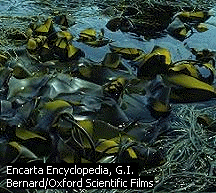 Algae
in the Intertidal Zone
Algae
in the Intertidal Zone Algae
Algae are a diverse group of simple, plantlike organisms. Like plants, most algae use the energy of sunlight to make their own food, a process called photosynthesis. However, algae lack the roots, leaves, and other structures typical of true plants. Algae are the most important photosynthesizing organisms on Earth. They capture more of the sun’s energy and produce more oxygen (a byproduct of photosynthesis) than all plants combined. Algae form the foundation of most aquatic food webs, which support an abundance of animals.
 Algae
in the Intertidal Zone
Algae
in the Intertidal Zone
Algae are widespread throughout the intertidal zone. Most have specialized adaptations for protection against drying when exposed during low tide. Some large algae called kelps are edible and are considered a food staple in some parts of the world. Extracts from kelp and other algae are used in the manufacture of products such as ice cream and cosmetics. Encarta Encyclopedia G.I. Bernard/Oxford Scientific Films
Algae vary greatly in size and grow in many diverse habitats. Microscopic algae, called phytoplankton, float or swim in lakes and oceans. Phytoplankton are so small that 1000 individuals could fit on the head of a pin. The largest forms of algae are seaweeds that stretch 100 meters (300 feet) from the ocean bottom to the water’s surface. Although most algae grow in fresh water or seawater, they also grow on soil, trees, and animals, and even under or inside porous rocks, such as sandstone and limestone. Algae tolerate a wide range of temperatures and can be found growing in hot springs, on snow banks, or deep within polar ice.
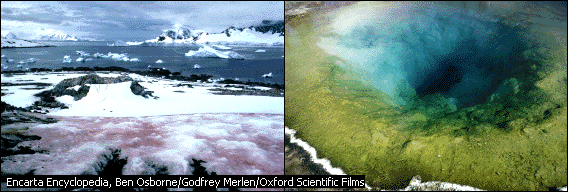 Ben
Osborne/Godfrey Merlen/Oxford Scientific FilmsAlgal Growth in
Extreme HabitatsAlgae are capable of living in habitats where few
other organisms could survive. They can live in virtually any habitat
in which there is sunlight and adequate moisture. Algae are found in
freshwater lakes, ponds, streams, swamps, on moist soil, wood, and
throughout the sunlit zones of the marine environment, as well as on
the snowfields and glaciers of Antarctica (left) and in thermal hot
springs at Yellowstone National Park (right).
Ben
Osborne/Godfrey Merlen/Oxford Scientific FilmsAlgal Growth in
Extreme HabitatsAlgae are capable of living in habitats where few
other organisms could survive. They can live in virtually any habitat
in which there is sunlight and adequate moisture. Algae are found in
freshwater lakes, ponds, streams, swamps, on moist soil, wood, and
throughout the sunlit zones of the marine environment, as well as on
the snowfields and glaciers of Antarctica (left) and in thermal hot
springs at Yellowstone National Park (right).
Algae also form mutually beneficial partnerships with other organisms (see Symbiosis). For example, algae live with fungi to form lichens—plantlike or branching growths that form on boulders, cliffs, and tree trunks. Algae live inside the cells of reef-building coral. In both cases, the algae provide oxygen and complex nutrients to their partner, and in return they receive protection and simple nutrients. This arrangement enables both partners to survive in conditions that they could not endure alone.
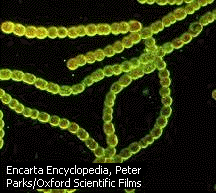 The
earliest life-forms on this planet are thought to be early ancestors
of cyanobacteria, a type of algae formerly called blue-green algae.
Fossilized cyanobacteria have been found in rocks more than 3 billion
years old. These early algae formed when there was no oxygen in the
atmosphere, and scientists theorize that as the algae
photosynthesized, they released oxygen as a byproduct, which
eventually accumulated in the atmosphere. Algae were probably the
first organisms capable of photosynthesis and, until the appearance
of plants on earth, the only photosynthesizers for billions of years.
The
earliest life-forms on this planet are thought to be early ancestors
of cyanobacteria, a type of algae formerly called blue-green algae.
Fossilized cyanobacteria have been found in rocks more than 3 billion
years old. These early algae formed when there was no oxygen in the
atmosphere, and scientists theorize that as the algae
photosynthesized, they released oxygen as a byproduct, which
eventually accumulated in the atmosphere. Algae were probably the
first organisms capable of photosynthesis and, until the appearance
of plants on earth, the only photosynthesizers for billions of years.
Like plants, most algae have rigid cell walls composed largely of cellulose. An exception is the diatom, whose cell wall is composed primarily of silica, which provides rigidity and also produces elaborately sculpted patterns of grooves that serve as identifying features. Many eukaryotic algae have whiplike appendages called flagella attached to their cell walls. By beating flagella in a rotary movement, these algae are able to move through water with considerable speed. A few algae that are devoid of rigid cell walls are able to protrude one part of the body ahead of the other to crawl on solid surfaces in an amoeba-like fashion.
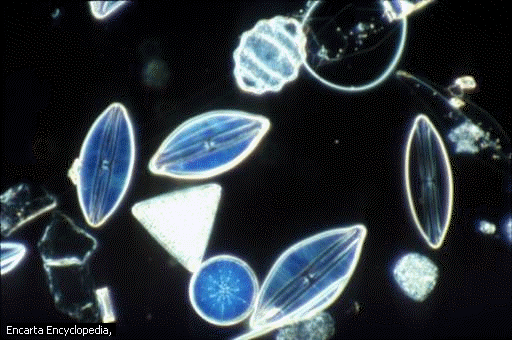 Diatoms,
single-celled algae with a cell wall made of silica, or glass, are
significant components of the phytoplankton, tiny, floating,
photosynthetic organisms that form the base of aquatic food chains.
Diatoms,
single-celled algae with a cell wall made of silica, or glass, are
significant components of the phytoplankton, tiny, floating,
photosynthetic organisms that form the base of aquatic food chains.
Algae come in a variety of shapes and forms. The simplest form is the single, self-sufficient cell, such as Euglena, dependent only on sunlight and carbon dioxide and minerals from the water. Numerous one-celled algae may clump together to form a colony. Although these cells are attached to one another, each cell within a colony continues to function independently. Still other algae are multicellular organisms. In the simplest multicellular algae, the cells are joined end to end, forming filaments, both branched and unbranched. More complex structures may be shaped like a small disc, tube, club, or even a tree. The most complex algae have highly specialized cells. Some seaweeds, for instance, have a variety of specialized tissues, including a rootlike holdfast, a stipe, which resembles a plant stalk, and a leaflike blade.
Algae reproduce in astoundingly diverse ways. Some reproduce asexually, others use sexual reproduction, and many use both. In asexual reproduction an individual reproduces without combining its genetic material with that from another individual. The simplest form of asexual reproduction is binary fission, in which a unicellular organism simply divides into two new individuals. Some multicellular algae, including Sargassum, reproduce asexually through fragmentation, in which fragments of the parent develop into new individuals. In a similar process called budding, special buds detach from multicellular algae and develop into new individuals, commonly found in Sphacelaria. Many algae produce special cells called spores that are capable of growing into new individuals. If these spores move about using flagella, they are known as zoospores.
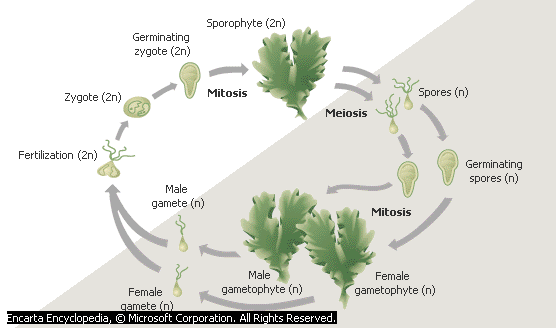 In
sexual reproduction, genetic material from two individuals is
combined. The simplest form of sexual reproduction in algae is
conjugation, in which two similar organisms fuse, exchange genetic
material, and then break apart. For example, in Spirogyra, which
produces both asexually and sexually, two long, unbranched filaments
join via conjugation tubes, through which genetic material is
exchanged between cells. Most multicellular algae undergo a more
complex form of sexual reproduction involving the union of special
reproductive cells, called gametes, to form a single cell, known as a
zygote.
In
sexual reproduction, genetic material from two individuals is
combined. The simplest form of sexual reproduction in algae is
conjugation, in which two similar organisms fuse, exchange genetic
material, and then break apart. For example, in Spirogyra, which
produces both asexually and sexually, two long, unbranched filaments
join via conjugation tubes, through which genetic material is
exchanged between cells. Most multicellular algae undergo a more
complex form of sexual reproduction involving the union of special
reproductive cells, called gametes, to form a single cell, known as a
zygote.
ALGAE USES
Human ingenuity has found many uses for algae. Algae provide food for people and livestock, serve as thickening agents in ice cream and shampoo, and are used as drugs to ward off diseases. More than 150 species of algae are commercially important food sources, and over $2 billion of seaweed is consumed each year by humans, mostly in Japan, China, and Korea. Algae are considered nutritious because of their high protein content and high concentrations of minerals, trace elements, and vitamins. The high iodine content of many edible algae may contribute to the low rates of goiter observed in countries where people frequently eat algae.
In coastal areas of North America and Europe, seaweeds are fed to farm animals as a food supplement. Cyanobacteria species that are high in protein, such as Spirulina, are grown commercially in ponds and used mostly as a health food and cattle dietary supplement. Seaweeds also are applied to soils as a fertilizer and soil conditioner, as their high concentrations of potassium and trace elements improve crop production. Some species of cyanobacteria can turn atmospheric nitrogen into ammonia, a form that can then be used by plants as a nutrient. Farmers in tropical countries grow cyanobacteria in their flooded rice paddies to provide more nitrogen to the rice, increasing productivity as much as tenfold.
Algae have been used for centuries, especially in Asian countries, for their purported powers to cure or prevent illnesses as varied as cough, gout, gallstones, goiter, hypertension, and diarrhea. Recently, algae have been surveyed for anticancer compounds, with several cyanobacteria appearing to contain promising candidates. Diatoms also have been used in forensic medicine, as their presence in the lungs can indicate a person died due to drowning.
Algae can also serve as indicators of environmental problems in aquatic ecosystems. Because algae grow quickly and are sensitive to changing environmental conditions, they are often among the first organisms to respond to changes.
Alan D. Steinman
Microsoft ® Encarta ® Encyclopedia 2002. © 1993-2001 Microsoft Corporation. All rights reserved.